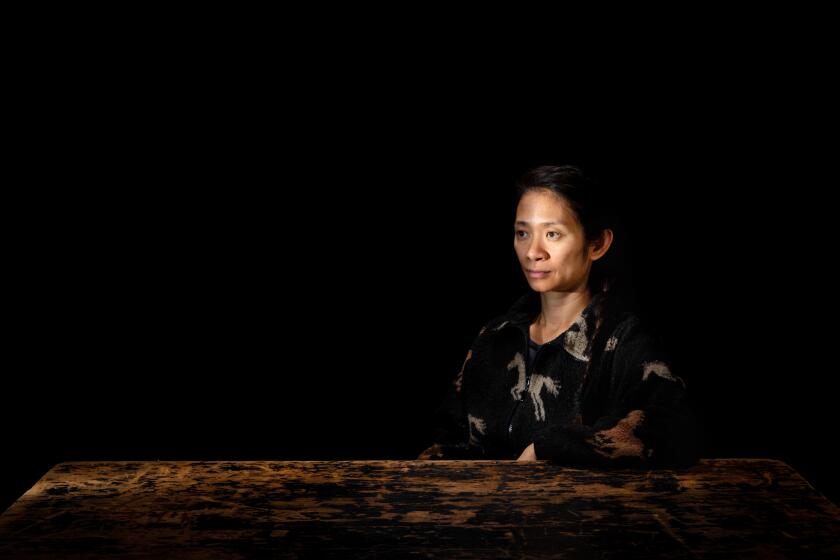‘Nomadland’ is the Oscars frontrunner. But its depiction of Amazon has stirred controversy
- Share via
A quietly poetic drama about people living all but invisibly on the margins of American society, director Chloé Zhao’s “Nomadland” has made a considerable amount of noise — and been anything but a fringe player — in this year’s topsy-turvy awards season.
Since its premiere last September at the Venice Film Festival, where it won the top Golden Lion prize, “Nomadland” has racked up virtually every award in its path, from the Golden Globes to the Producers Guild Awards to this past weekend’s BAFTAs. Heading into the Oscars on April 25, the Searchlight Pictures release is nominated for six awards, including best picture and director, and is widely considered the film to beat.
But being the frontrunner brings with it an added level of scrutiny, and “Nomadland” has come in for its share of criticism since its release in theaters and on Hulu in February. Even as many have praised the film for its sensitive, authentic depiction of itinerant workers, others have griped that it glosses over the harsher realities of the modern gig economy and, in particular, what it’s like to work in an Amazon warehouse and participate in the company’s seasonal CamperForce program.
In a recent op-ed in The Times, ProPublica reporter Alec MacGillis, author of “Fulfillment: Winning and Losing in One-Click America,” argued the film, which is centered on the experience of a nomad named Fern, played by Oscar winner Frances McDormand, sidesteps what he says are dehumanizing and potentially injurious working conditions at Amazon. “The visual power of the film and its emotional core, Fern’s grief over the loss of her husband and her former life, occupy the audience’s attention, not Amazon’s problems,” MacGillis wrote. “One could easily come away from the movie having a benign view of the toll Amazon takes on its workers, including the temporary ones.”
Critics see the film, adapted by Zhao from journalist Jessica Bruder’s 2017 book “Nomadland: Surviving America in the Twenty-First Century,” as a missed opportunity that omits the nonfiction work’s most damning passages. Others counter that the critically acclaimed picture is a stirring character study, not a work of muckraking journalism.
How three nomads — Linda May, Charlene Swankie and Bob Wells — brought authenticity and heart to Oscar contender ‘Nomadland.’ And an update on Swankie’s health.
The debate has gained traction in recent weeks amid a closely watched and ultimately unsuccessful unionization effort by workers at an Amazon facility in Bessemer, Ala. The union push highlighted what many Amazon critics say are punishing working conditions in the company’s warehouses, with workers relentlessly driven to perform monotonous and physically taxing work at an ever-faster rate in order to hit algorithm-mandated targets, subjecting themselves to potential repetitive-motion injuries — criticisms that Amazon has long pushed back against.
“I thought there was a lot about the film that was very beautiful but it left more than a bitter taste in my mouth,” says Tim Shadix, legal director of the California-based nonprofit advocacy organization Warehouse Worker Resource Center, who points to a 2019 study that found that the injury rate at Amazon warehouses was more than twice as high as in the general warehousing industry. “I felt like the portrayal of all of the work in the film, but particularly the Amazon work, paints a very misleading picture of what our economy is like. It shows Amazon as a place to make money and enable someone’s personal journey, not really dealing with how dark it is that you have companies that are taking advantage of often senior people who should be retired but, because of economic circumstances, are working in horrifically dangerous jobs.”
In a statement, Amazon spokesman Andre Woodson told The Times, “We are proud of our innovative CamperForce program and the opportunities it offers for individuals to combine earning extra money during the holiday season with RV camping. CamperForce provides employees with at least $15 per hour, partial campsite accommodations and hook-ups for their vehicles ... Hundreds of our seasonal employees are part of our CamperForce program, many of whom return year after year to help fulfill customer orders during our Peak season. Within the CamperForce program specifically, we see many of these employees return and tell us of their positive experience.”
While researching her book, Bruder spent a week working in an Amazon warehouse in Texas and witnessed some of its potential dangers. She writes of one 70-year-old CamperForce worker, Chuck Stout, who was stationed near a conveyor belt when a box flew off and knocked him down, causing him to hit his head on the concrete floor. After Amazon’s in-house medics determined he hadn’t suffered a concussion, Stout was sent back to the job that had him walking some 15 miles a day.
The book’s central character, Linda May, who plays herself in the film, developed a debilitating repetitive-motion wrist injury from operating a handheld barcode scanner for hours every day, with pain radiating along the entire length of her arm. Working through the Christmas rush, Bruder writes that Linda May felt like “a cog in the world’s largest vending machine.”
None of those hazards are seen in the film, however, in which Fern is shown packing boxes and placing products on shelves in an Amazon warehouse, declaring at one point that the gig is “great money.”
The Oscar-nominated director reflects on the need to be vulnerable and put yourself out there.
Zhao, who is also in the midst of post-production on the upcoming Marvel epic “The Eternals,” has not directly addressed the criticisms, but she has indicated the film is not meant to minimize hardships in the nomad lifestyle. “If you look deeply, the issue of eldercare as a casualty of capitalism is on every frame,” Zhao said in a New York magazine profile back in February. “It’s just, yes, there’s the beautiful sunset behind it.”
In a statement, Amazon’s Woodson said, “The health and safety of our employees is our number one priority — and has been since day one. We work closely with health and safety experts and scientists, conduct thousands of safety inspections each day in our buildings, and have made hundreds of changes as a result of employee feedback on how we can improve their well-being at work.”
To gain access to shoot in an Amazon fulfillment center in Fernley, Nev., McDormand, who also produced the film, wrote a letter to Jeff Blackburn, Amazon’s senior VP of business and corporate development. “It was right before they started giving people $15 an hour,” McDormand told The Hollywood Reporter last year. “This was a really smart move for them because ... we are telling a story about a person who is benefiting from hard work, and working at the Amazon fulfillment center is hard work, but it pays a wage.”
Bob Wells, an advocate for the nomadic community and co-founder of Home on Wheels Alliance, argues that the criticism of the depiction of Amazon in “Nomadland,” while understandable, is ultimately misplaced. Though Wells, who plays himself in the film, has personally never worked at Amazon, over the years he has spoken to many nomads who have. While he has heard first-hand accounts of how physically difficult the work can be, particularly for older workers, he says the CamperForce program — which launched in 2008 and operates at more than 25 Amazon facilities across North America — is in high demand as a way to make good money relatively quickly.
“I think people are conflating the regular Amazon employees that are there year-round, year after year, with the CamperForce, and I’m not sure that is a fair comparison,” Wells says. “The truth is that I think the CamperForce is treated reasonably well. I think people are taking their massive hatred for the corporate world, which is in my mind 100% valid, and they’re trying to shoehorn the CamperForce in there as evidence to back up their argument. Corporations do need to be controlled. But the CamperForce isn’t a prime example of the fault. I think if you’re basically healthy, the CamperForce is a very good thing.”
In Hollywood, support for “Nomadland” appears to remain strong as evidenced by the film’s continued domination of awards season. With the film business struggling to come back from the pandemic, competition for awards this year has been relatively congenial, and few seem to have the appetite to publicly go after a perceived frontrunner over a potential vulnerability. (Hardball campaigns can easily backfire and several recent films have claimed Oscar gold in spite of controversy, including contenders as varied as “Bohemian Rhapsody,” “Green Book” and “Joker.”)
Meanwhile, Amazon itself is a significant player this awards season with its film division having released nominated titles “Borat Subsequent Moviefilm,” “One Night In Miami...,” “Sound of Metal” and “Time.”
The award-winning road movie from the writer-director Chloé Zhao is a gorgeous, lyrical weave of documentary and fiction.
Speaking to The Times in February, Bruder had nothing but praise for “Nomadland,” crediting Zhao — who, having taken top honors this past weekend at the Directors Guild Awards, could become the first woman of color to win the directing Oscar — for presenting viewers with a window onto an aspect of life in America that has thus far been largely ignored.
“I always hoped and expected that Chloé would do this with a light touch that would show the full nuance of the situation,” Bruder said. “Part of what happens, we hope, in a book of narrative non-fiction or a film is that it becomes a vector for empathy. Rather than exoticizing a group of people, you recognize in them bits of people you know and bits of yourself. Maybe this makes me sound like a bit of a hippie. But I consider it a connective sort of storytelling.”
More to Read
Only good movies
Get the Indie Focus newsletter, Mark Olsen's weekly guide to the world of cinema.
You may occasionally receive promotional content from the Los Angeles Times.












